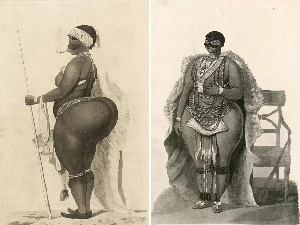Her story has been told severally, for many years, as the African woman who suffered and was exploited because of a condition she had; steatopygia.
Sarah Baartman derived from Saartje, had extremely protruding buttocks and hips because of steatopygia; a condition that contributes to the accumulation of large amounts of fat on the buttocks.
She is said to have been born to a Khoikhoi family in South Africa’s Eastern Cape in 1789. The Khoikhois were nomadics in South Africa. Her mother died when she was two years old and her father who was a cattle driver, died when she was an adolescent.
She subsequently got married as a teenager to a man from her tribe; a Khoikhoi who was later murdered by his slave master; a Dutch colonist.
Sarah then entered domestic service in Cape Town in South Africa to survive and it was during this period that her woes began.
According to a BBC magazine piece, Sarah was discovered during this period by a British surgeon; William Dunlop after one of her bosses; Hendrik Cesars whose place she worked as a domestic worker, started showing her at a city hospital in Cape Town in exchange for cash.
Fascinated by her condition and body, he promised to take her abroad to work as an ‘indentured servant’ and asked that she sign a contract in that regard.
Although illiterate, Baartman signed the contract which she only realized later was meant for a different purpose.
She was sent to Europe where she was exhibited in many British freak shows in London at a venue in the Piccadily Circus with the stage name “Hottentot Venus” – now seen as derogatory – but then being used in Dutch to describe the Khoikhoi and San, who together make up the peoples known as the Khoisan.

A Photo from the British Museum – Source: BBC
The BBC magazine feature indicates that she was made to wear skin-tight, flesh-coloured clothing, as well as beads and feathers and she smoked a pipe on stage, singing and dancing. Rich persons in the audience sometimes paid for private exhibitions in their homes where guests were allowed to touch her.
She is said to have also been suspended sometimes in a cage on stage while being poked, prodded, and groped.
In 1807 after slave trade had been abolished by the British Empire, campaigners who were disgusted by Baartman’s treatment in London filed a lawsuit against her employers for holding her against her will.
Unfortunately, she testified when called to court, in favour of her employers – this has raised questions about whether she was forced to do the exhibitions against her will or whether she was threatened with consequences if she had testified against her employers in court.
But after campaigners lost the case, Sarah went to Paris with Cesars, where she was sold to an exhibitor; S. Réaux. She drank, smoked heavily, and was ‘probably prostituted’ by him.
She even agreed to be studied and painted by some scientists and artists although she refused to be completely naked before them with reason that it was beneath her dignity.
Baartman is said to have died at the age of 26 from ‘inflammatory and eruptive disease’ which is said to be resultant of pneumonia, syphilis, or alcoholism. She died on December 29, 1815, but her exhibition continued.
According to BBC, “The naturalist Georges Cuvier, who had danced with Baartman at one of Reaux’s parties, made a plaster cast of her body before dissecting it. He preserved her skeleton and pickled her brain and genitals, placing them in jars displayed at Paris’s Museum of Man. They remained on public display until 1974, something Holmes describes as “grotesque”.
After the election of Nelson Mandela as South Africa’s president in 1994, he requested the repatriation of Baartman’s remains and the plaster cast by Cuvier.

2002: The re-interment of Baartman’s remains takes place in South Africa – Source: BBC
In March 2002, after the French government agreed to this, Baartman’s remains were sent back to South Africa, and in August of that year, her remains were buried in Hankey in Eastern Cape province, a hundred and ninety-two (192) years after Baartman had left for Europe.
 Home Of Ghana News Ghana News, Entertainment And More
Home Of Ghana News Ghana News, Entertainment And More





